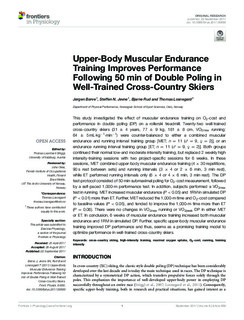| dc.contributor.author | Børve, Jørgen | |
| dc.contributor.author | Jevne, Steffen N. | |
| dc.contributor.author | Rud, Bjarne | |
| dc.contributor.author | Losnegard, Thomas | |
| dc.date.accessioned | 2018-04-13T11:08:47Z | |
| dc.date.available | 2018-04-13T11:08:47Z | |
| dc.date.created | 2017-12-12T08:44:28Z | |
| dc.date.issued | 2017 | |
| dc.identifier.citation | Frontiers in Physiology. 2017, 8, 690 | |
| dc.identifier.issn | 1664-042X | |
| dc.identifier.uri | http://hdl.handle.net/11250/2494063 | |
| dc.description | This is an open-access article distributed under the terms of the Creative Commons Attribution License (CC BY). The use, distribution or reproduction in other forums is permitted, provided the original author(s) or licensor are credited and that the original publication in this journal is cited, in accordance with accepted academic practice. No use, distribution or reproduction is permitted which does not comply with these terms. | |
| dc.description.abstract | This study investigated the effect of muscular endurance training on O2-cost and performance in double poling (DP) on a rollerski treadmill. Twenty-two well-trained cross-country skiers (31 ± 4 years, 77 ± 9 kg, 181 ± 8 cm, VO2max running: 64 ± 5 mL·kg−1·min−1) were counter-balanced to either a combined muscular endurance and running interval training group [MET; n = 11 (♂ = 9, ♀ = 2)], or an endurance running interval training group [ET; n = 11 (♂ = 9, ♀ = 2)]. Both groups continued their normal low-and moderate intensity training, but replaced 2 weekly high intensity-training sessions with two project-specific sessions for 6 weeks. In these sessions, MET combined upper-body muscular endurance training (4 × 30 repetitions, 90 s rest between sets) and running intervals (3 × 4 or 2 × 6 min, 3 min rest), while ET performed running intervals only (6 × 4 or 4 × 6 min, 3 min rest). The DP test-protocol consisted of 50 min submaximal poling for O2-cost measurement, followed by a self-paced 1,000-m performance test. In addition, subjects performed a VO2max test in running. MET increased muscular endurance (P < 0.05) and 1RM in simulated DP (P < 0.01) more than ET. Further, MET reduced the 1,000-m time and O2-cost compared to baseline values (P < 0.05), and tended to improve the 1,000-m time more than ET (P = 0.06). There were no changes in VO2max running or VO2peak DP in either MET or ET. In conclusion, 6 weeks of muscular endurance training increased both muscular endurance and 1RM in simulated DP. Further, specific upper-body muscular endurance training improved DP performance and thus, seems as a promising training model to optimize performance in well-trained cross-country skiers. | |
| dc.language.iso | eng | |
| dc.subject | cross-country skiing | |
| dc.subject | high-intensity training | |
| dc.subject | maximal oxygen uptake | |
| dc.subject | O2-cost | |
| dc.subject | running | |
| dc.subject | training intensity | |
| dc.title | Upper-Body Muscular Endurance Training Improves Performance Following 50 min of Double Poling in Well-Trained Cross-Country Skiers. | |
| dc.type | Peer reviewed | |
| dc.type | Journal article | |
| dc.description.version | publishedVersion | |
| dc.rights.holder | © 2017 Børve, Jevne, Rud and Losnegard | |
| dc.source.volume | 8 | |
| dc.source.journal | Frontiers in Physiology | |
| dc.source.issue | 690 | |
| dc.identifier.doi | 10.3389/fphys.2017.00690 | |
| dc.identifier.cristin | 1526035 | |
| dc.description.localcode | Seksjon for fysisk prestasjonsevne / Department for Physical Performance | |
| cristin.unitcode | 150,31,0,0 | |
| cristin.unitname | Seksjon for fysisk prestasjonsevne | |
| cristin.ispublished | true | |
| cristin.fulltext | original | |
| cristin.qualitycode | 1 | |
